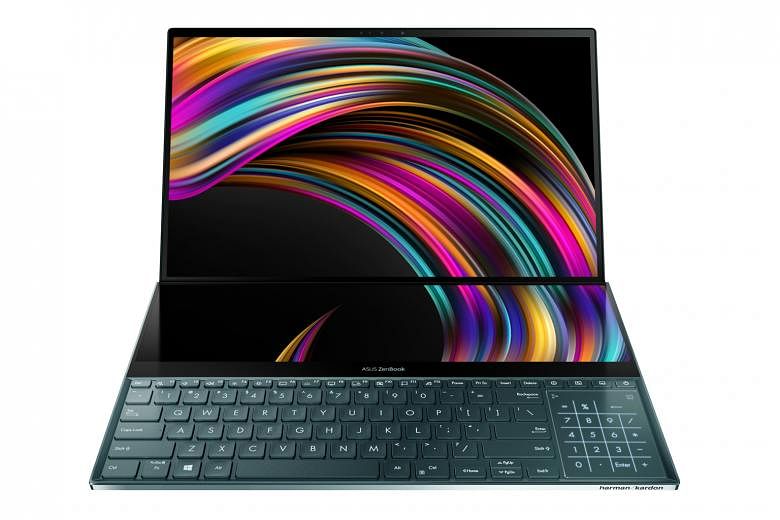Innovation has run amok - that was my first thought when I saw the Asus ZenBook Pro Duo laptop, which adds a second, ultra-wide touchscreen above the keyboard.
This 14-inch display, dubbed ScreenPad Plus, spans the entire width of the ZenBook and is like an enormous version of the Apple MacBook Pro's Touch Bar.
But while the Touch Bar offered contextual controls for compatible apps, the ScreenPad Plus can fit three windowed apps side by side.
To use the ScreenPad Plus, drag an app window from the ZenBook's main 15.6-inch screen to the second screen.
Or open an app in the ScreenPad via the Launcher control panel by swiping in from the left edge of the touchscreen.
The ZenBook will resize the app window if you place multiple apps (up to three) in the ScreenPad Plus.
However, some apps, such as the Razer Synapse app, do not play nice and will take up slightly more than a third of the screen. In such cases, there will be some overlap of the app windows if you try to fit in three apps.
Thankfully, there is no need to open and rearrange the apps in the ScreenPad Plus each time you restart the laptop.
-
FOR
• Stunning Oled 4K screen
• Latest high-end hardware suitable for content creation and gaming
-
AGAINST
• Extra screen has issues with full-screen apps
• Large and heavy chassis requires plenty of desktop space
• Pricey
-
SPECS
PRICE: $4,998
PROCESSOR: Intel Core i9-9980HK (2.4GHz)
GRAPHICS: Nvidia GeForce RTX 2060 6GB GDDR6
RAM: 32GB DDR4
SCREEN SIZE: 15.6 inches, 3,840 x 2,160 pixels, 14.1 inches, 3,840 x 1,100 pixels
CONNECTIVITY: Thunderbolt 3, 2 x USB 3.1 Gen 2 Type-A, HDMI, audio jack
BATTERY: 71 watt-hour
-
RATING
FEATURES: 4.5/5
DESIGN: 3.5/5
PERFORMANCE: 4.5/5
BATTERY LIFE: 2/5
VALUE FOR MONEY: 3.5/5
OVERALL: 3.5/5
Asus has included a feature that saves the open apps and their exact locations on the ScreenPad Plus. Users can easily restore their favourite or frequently used apps by clicking a button in the Launcher.
For heavy multi-taskers or content creators who need more screen real estate for multiple apps, the ScreenPad Plus seems like a good idea.
For instance, the timeline for a video editing app or the colour palette tool for a photo editor could be placed in the second screen, thus allowing more screen space on the primary display for the actual content.
Even casual users will appreciate the extra screen as a place for messaging, video or music playback apps.
Given the relative lack of innovation in notebooks, the ZenBook Pro Duo with its audacious ScreenPad Plus feels like a breath of fresh air. But it is far from perfect.
The biggest issue I faced was that games or apps running in full-screen mode would be minimised to the taskbar if I moved the mouse cursor down to the ScreenPad Plus and clicked the mouse button.
These accidents happened often enough that I had to disable the ScreenPad Plus during online gaming.
To accommodate its extra screen, the keyboard has been moved down to the bottom edge.
The touchpad, which doubles as a number pad, is now on the right.
This design is similar to the one on Asus' Zephyrus gaming laptops and poses its own problems, which Asus implicitly acknowledges by including a separate palm rest to alleviate the strain of using this keyboard.
But adding the palm rest increases the footprint of the ZenBook and is impractical to use on the go.
Asus has bundled a stylus to use with the ZenBook's two screens.
But to use it with the ScreenPad Plus would mean resting your wrist and arm on the keyboard, which is not ideal for extended use.
Another quibble is that the matte ScreenPad, which uses in-plane switching display technology, pales in comparison with the vibrant and glossy main display, which is an Oled screen.
This discrepancy in screen quality is jarring if you extend the main display to the second screen - for instance, images would look lively in the upper, main screen and dull in the second display.
These issues aside, the ZenBook does everything right from a computing hardware perspective.
It has an eight-core Intel Core i9-9980HK processor with 32GB of system memory and a 1TB solid-state drive.
Its mid-tier Nvidia GeForce RTX 2060 graphics chip will run most games without a hitch while its Wi-Fi chipset supports the latest Wi-Fi 6 standard for faster and more reliable wireless connections.
Unsurprisingly, the ZenBook's PCMark 10 score (5,486) rivals that of a high-end gaming notebook like the Razer Blade 15 Advanced Model (5,494).
Its battery life is only slightly longer than that of gaming laptops'. It clocked 4hr48min in our video-loop battery test.
Try it before you buy - that is my advice for those keen on the ZenBook Pro Duo.
Personally, I do not find it as useful as Asus claims. But perhaps its target audience - content creators and power users - may disagree.


